Audio Engineering Midterm
1/115
Earn XP
Description and Tags
YOU BETTER STUDY
Name | Mastery | Learn | Test | Matching | Spaced |
|---|
No study sessions yet.
116 Terms
What is a microphone?
A transducer
How is a microphone like a speaker?
It’s like a speaker in reverse (TEST)
Parts of a mic
A diaphragm that is stretched over the coil, ribbon, or plates, along with other parts to complete the transducing process
Mic technologies
Magnetic Induction and Variable Capitence
Magnetic Induction(type of mic)
Moving Coil(Dynamic), Ribbon
Variable Capitence(type of mic)
Condenser
Each mic and mic type is a measure of what
Voltage and energy of diapragm
Electromagnetic(dymanic)
Wrap wire around a nail; connect the wires to a volt meter; move it over a magnet and measure voltage / energy.
Dynamic Mic Characteristic(moving coil)
Inexpensive, rugged/sturdy, Least sensitive, Capable of handling high SPL
Popular Dynamic Mics
Shure SM57 / SM58 / SM7B Developed in the 1930’s /UniDyne Sennheiser 421 ElectroVoiceRE-20 / RE-15
Magnetic Induction
The element of a ribbon microphone works much like its own diaphragm. It is made from a thin strip of metal suspended between a magnet. (RCA’s began developing in 1920’s (44))
Ribbon Microphone (magnetic induction)
Electrical signal is measured by how fast the ribbon moves, not how far.
Ribbon Mic traits
uses corrugated, thin ribbon suspended in magnetic field Air Pressure differences between front & back cause it to move
Ribbon Mic characteristics
more fragile, more expensive, more sensitive than moving coil, have a small output level =poor SNR, not used in high SPL situations (high AIR pressure levels), noisy in distant mic situations
Condenser Mics
The element of a condenser microphone contains a diaphragm one fixed
Condenser Mic characteristics
Condenser mics are the only mics that require power, either by batteries, an external power supply, or phantom power: 48VDC, most sensitive, Most expensive, Can Handle High SPL
Phantom Power
Condenser Mics, 48DVC
General Mic Selection Considerations
Proximity Effect
High SPL / Overload
Frequency Response
Signal-to-noise ratio
Harmonic Distortion
Sensitivity
Proximity Effect
increase in LF response when placed near sound source; typical of directional mics
Most sensitive mic
Condenser Mic
Least Sensitive Mic/Most rugged Mic
Moving Coil, Dynamic
Most fragile Mic
Ribbon
How to minimize proximity effect
distance ( > 1 ft.)
Low Freq. roll-off filter
change pattern (omni-directional)
use a“pop filter”to keep singer back
use slightly off-axis
Bass roll-off/High pass
Reduces the low end frequency
rumble
low frequency vibration conducted through adjoining surfaces
How to reduce rumble
shock mount, bass roll off, using a mic with a reduced LF response
Shock mount
wraps around mic to reduce rumble, it keeps it from transmitting to mic, but does not protect mic
Polar/pickup pattern
A microphone’s directiona lsensitivity varies with frequency.
Polar/pickup pattern traits
The Higher the frequency, the more directional a mic becomes.
The lower the frequency, the less directional it becomes regardless of its pickup pattern.
Polar pattern def
a mic’s sensitivity with respect to direction and frequency
uni-directional
Picks up sound primarily in one direction (heart like shape-cardioroid)
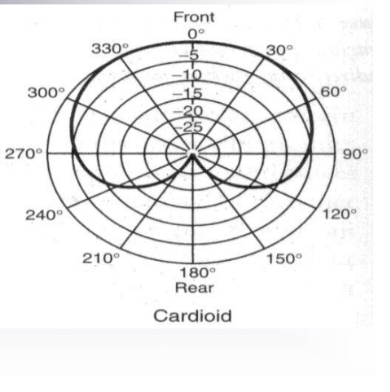
omni-directional
picks up sound equally in all directions
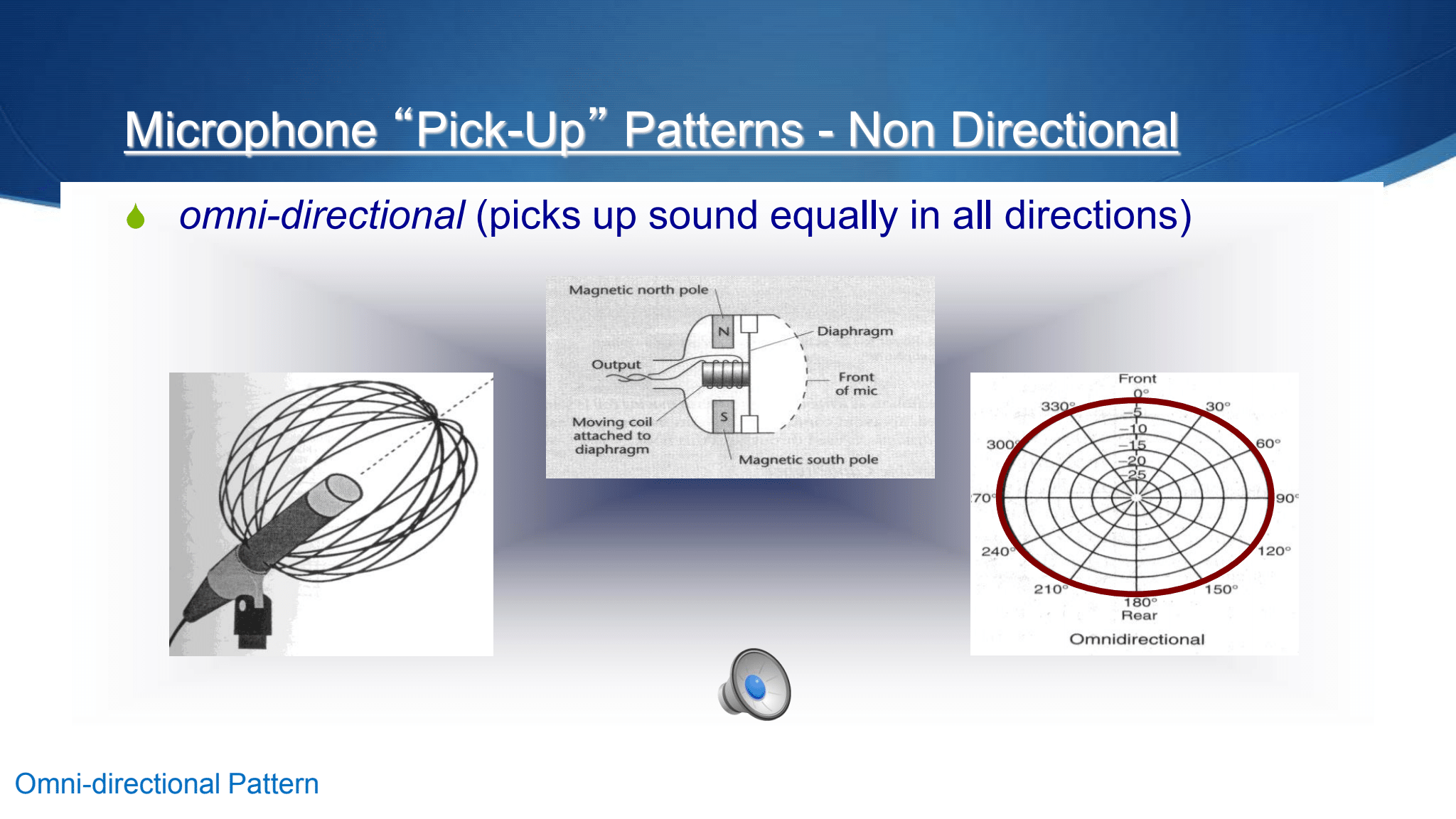
bi-directional
equally picks up sound from two opposite directions (figure eight)
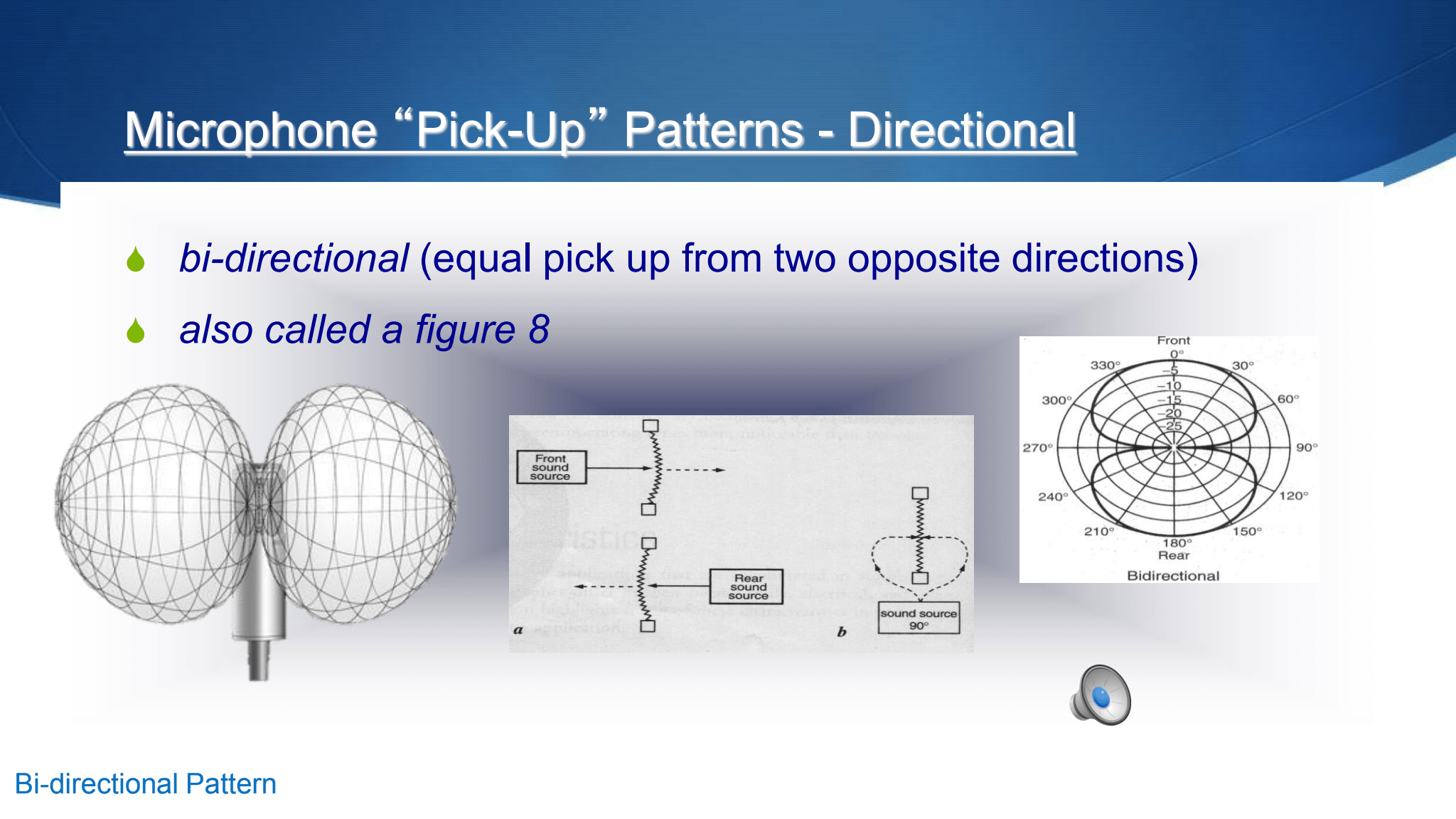
hypercardioroid

super—cardioroid
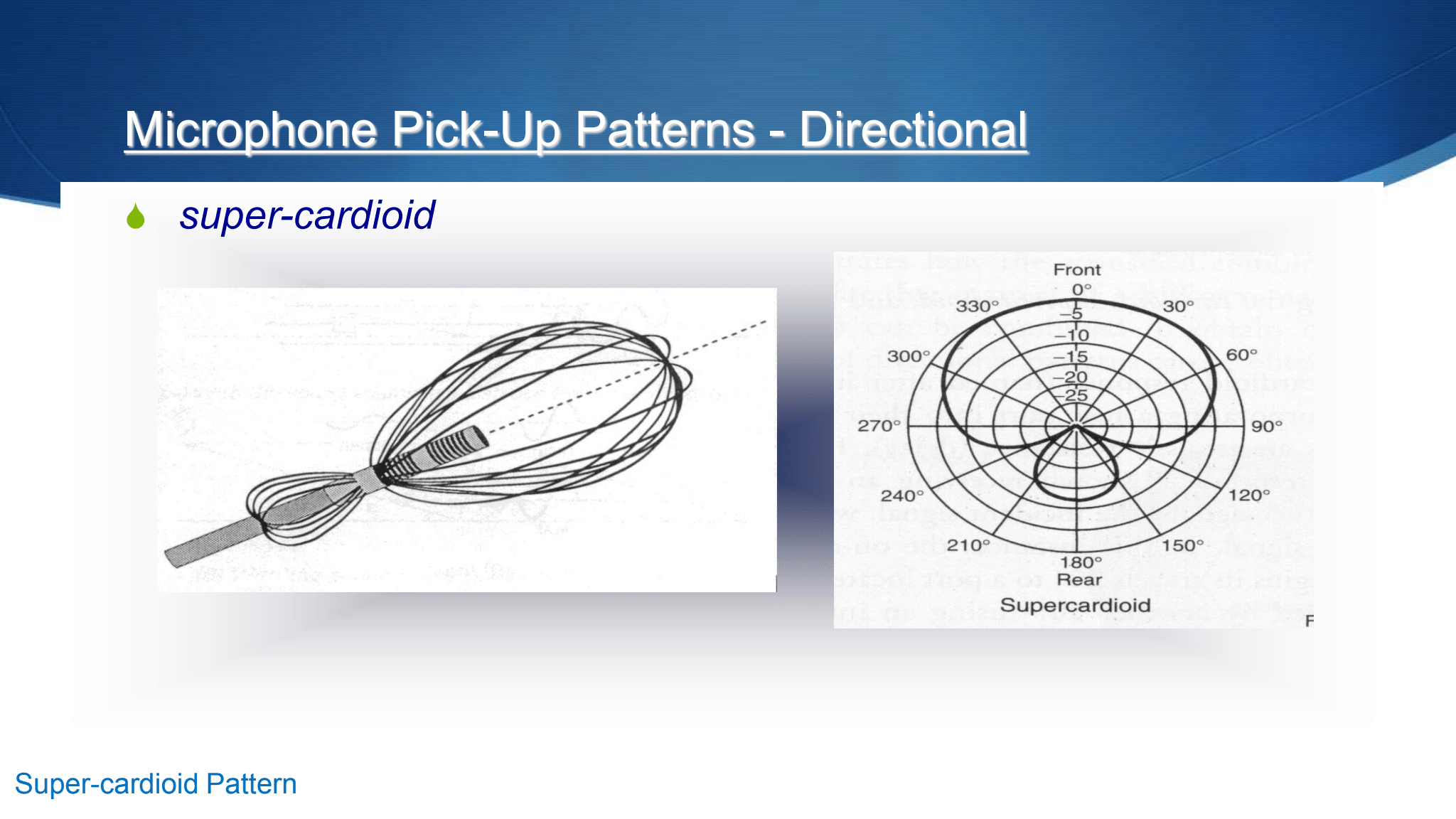
Multiple pattern directional mics
mics that are capable of switching from one pick-up pattern to another
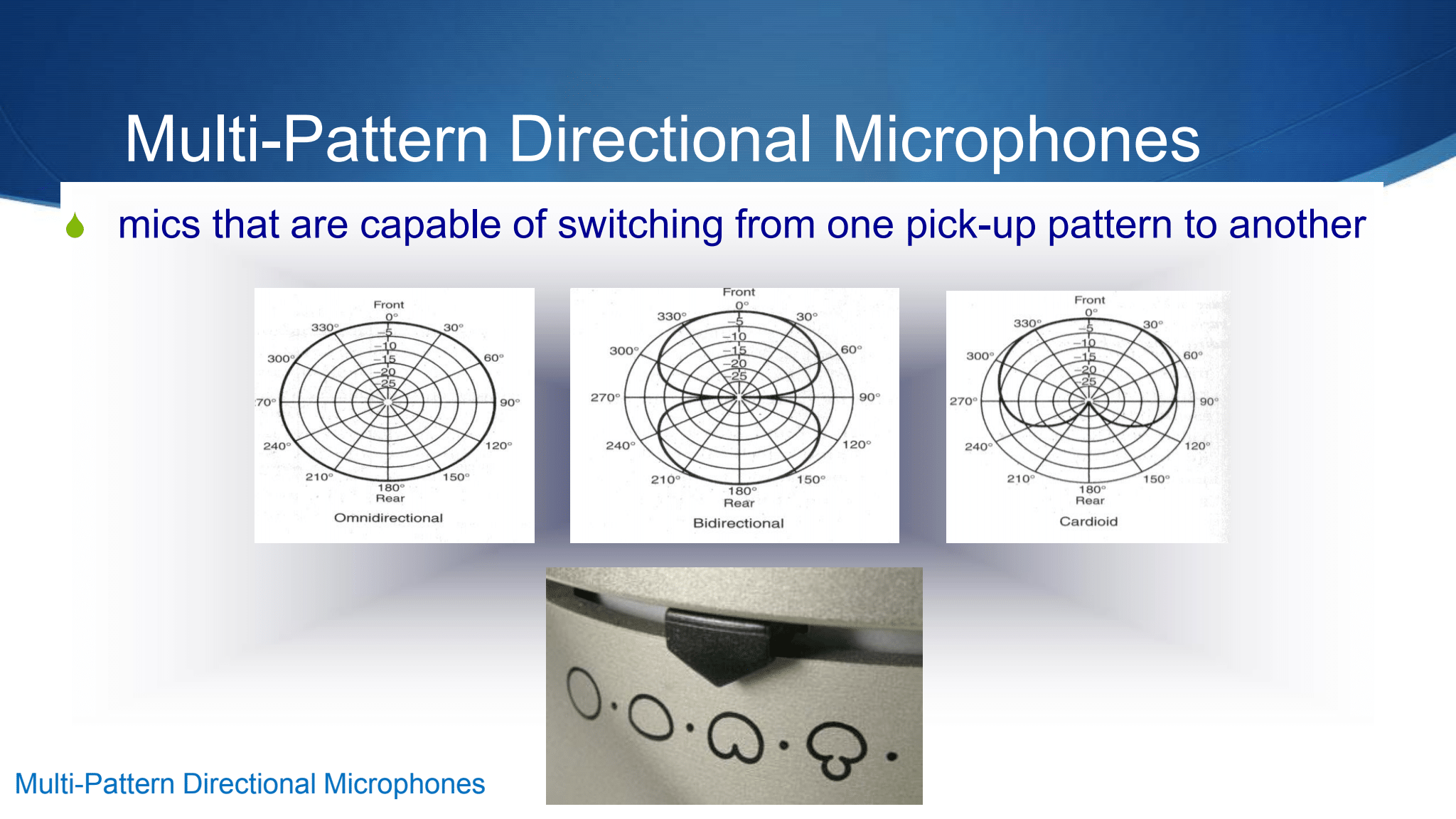
The sound a mic receives is dependent on what
The nature of the sound source
The acoustic environment
The placement of themic
Close mic technique
Dry, more intimate sound
Control Sound Sources
Control Leakage
Allow use of FX later
Distant mic technique
More open acoustic sound
More natural sounding
close” micing (< 3 ft. from source)
aids sound isolation
adds“presence”
minimizes acoustics
little phase cancellation
distant (“distance”) (> 3 ft. from source)
natural blend acoustical space
room tone or ambiance
high probability of phase
On axis
Singing directly into the mic
off axis
A bit off center/roll off the bass a bit
3:1 rule
each mic must be at least 3x farther apart than each is from its source
Stereo micing
is concerned with picking up a sense of left/right stereo imaging...
use of two microphones to obtain a“coherent stereo image
Spaced pair
2 identical mics
Spaced 3-30ft apart
Likely to have phase problems
Coincident(X/Y)
2 identical mics
capsules aligned
angled 90°-135°
minimal phase problems
Near coencident
2 identical mics
elements angled 90°–130°apart
possibility of phase problems
Near coincident ORTF
(2identical mics,“near-coincident”, angle of 110 degrees)
M/S(midside)
2 complimentary mics
1 directional, 1 bi-directional
capsules aligned
minimal“phasing”
Deca tree
uses 3 omnimics
placed in “T” 8-20in. apart
Used in film scoring
Basic techniques
Large Diaphragm mics best suited for capturing low frequency information.
Small best suited for Higher frequencies.
Loudspeaker
the last link of the soundchain.
a device that helps usevaluate the quality ofevery sound
transducer
converts one type of energy (electric) into another type (acoustic)
Types of loudspeakers
Moving-coil (most common)
Ribbon
Electrostatic
Cone(loudspeaker anatomy)
Made of paper or plastic
Basket(loudspeaker anatomy)
Metal frame around the speaker
Voice coil(loudspeaker anatomy)
Electro magnetic coil of wire
Spider(loudspeaker anatomy)
Holds the coil in place
Woofers
Biggest cones
Produce low frequencies
Tweeters
Smallest cones
Produce high frequencies
Crossover frequency
the point where the frequency spectrum is divided into low and high frequencies, and sometimes mid.
Active crossover
when each driver (tweeter, woofer, sub) has its own channel of amplification. This dramatically increases the available power, dynamic range (softest to loudest sounds), and your control of the system’s tonal response over the whole audio spectrum.
Passive crossover
doesn’t need to get hooked up to a power source to work. There are two kinds of passive crossovers: component crossovers that connect between the amplifier and speakers, and in-line crossovers that fit in between the receiver and the amp.
Two way system
If a loudspeaker is divided once
Frequency(judging a loudspeaker)
Just like microphone response curves....We desire a wide response
the measure of an audio system’s ability to reproduce a range of frequencies with the same relative loudness...
Distortion(judging a loudspeaker
IM (intermodulation-two or more frequencies (usually high) combine and create dissonance unrelated to the original signal),
THD (total harmonic distortion-harmonics is added to the signal that were not present in the original signal
Signal in the reproduced sound that was not part of the original (in %)
Output level(judging a speaker)
Good monitors will reproduce clean signal to 110db SPL
Sensitivity(judging a speaker)
Anywhere from 80db to 100db.
On-axis(directly infront of speaker)SPL(in dB) produced at given distance (1m)with given power (1W)
“efficiency”of loudspeaker
Polar response (judging a speaker)
How a loudspeaker focuses sound at the listening position (HORIZONTAL AND VERTICAL DISPERSION)
Harmonic distortion
harmonics in output not present at input
Intermodulation distortion
“combination tones” produced
Overload distortion
signal is louder than the system can handle
Transient distortion
system cannot accurately reproduce rapid ‘attack’
PHANTOM IMAGE (IMPORTANT)
Occurs when you are listening at anequal distance between two speakers.
Center =“free field
+0 dB
Against wall =“half space”
+3 dB
In upper corner =“eighth space”
+9 dB
In corner =“quarter space”
+6 dB
cone motion IN PHASE
sound from two speakers COMBINE
cone motion OUT OF PHASE
sound from two speakers CANCEL
FAR-FIELD MONITORING (IMPORTANT)
Larger, full-range loudspeakers
Typically built into wall
Located several feet from listener
NEAR FIELD MONITORING (IMPORTANT)
Smaller, limited rangeloudspeakers
Set on stands or consolebridge
Located near to listening position (room acoustics do not affect listener)
Surround SOund
designed to envelope the listener in the audio
5:1
5 full range speakers•1 sub woofer (home theaters)
Frequency response in audio is defined as
the measure of an audio system's ability to reproduce a range of frequencies with the same relative loudness.
A "crossover" in a loudspeaker design
divides the frequency range into lows, highs, and sometimes mids, to go to different speakers for reproduction.
In loudspeaker design, tweeters have smaller cones than woofers, and can produce higher frequencies than woofers.
true
The advantage of using loudspeakers to monitor with is that you don't have to worry about the room influencing what you hear.
false
The most common type of loudspeaker is
Moving coil
Mixer
Small•Portable•LimitedPerformance
Console
Larger•Notportable•Provide manyprocessingfunctions•May containcomputer-assistedfunctions
Analog Console
Large, expensive, use lots of power•One knob / switch per function•Sometimes, computer assist withMutes / Levels•Easy to understand
Digital Console
Performance rivaling large analog consoles but with a smaller‘footprint’•Software upgradeable•More complex
Control Surfaces
Integration with Digital AudioWorkstation / DAW•Tactile interface with software•Have all the ‘Look / Feel’ of an analog desk•No audio passing through the desk•Just a Giant sophisticatedMouse!
Why do we need audio consoles
Using multiple microphones•One mic per instrument‘
Adding’ instruments to original recording
‘overdubbing’
Adding ‘processing’ to signal•EQ•Compression, etc.
Separate control of recording & monitoring•recorder•monitors, headphones
BASIC CONSOLE FUNCTIONS
Amplifies•adjusts incoming signal“volume”(‘pre-amp’)
Processes•adjusts 'tone' (EQ) or ‘dynamics’(compressor)
Balances/Blends•“mix” (‘fader’)Combines•“spatial positioning” (‘pan-pot’)
Routes•recorder•effects•monitors, headphones
Signal flow
The path a signal takes to it’s destination..
Pan pot
control that can shift the balance of sound to any point from left to right between two output buses•
allows creation of “stereo image”(spatial positioning)
Signal Processer
A DEVICE THAT ALTERS THE CHARACTERISTIC OF A SOUND.
SIGNAL PROCESSORS ARE GROUPED INTO FOUR CATEGORIES.